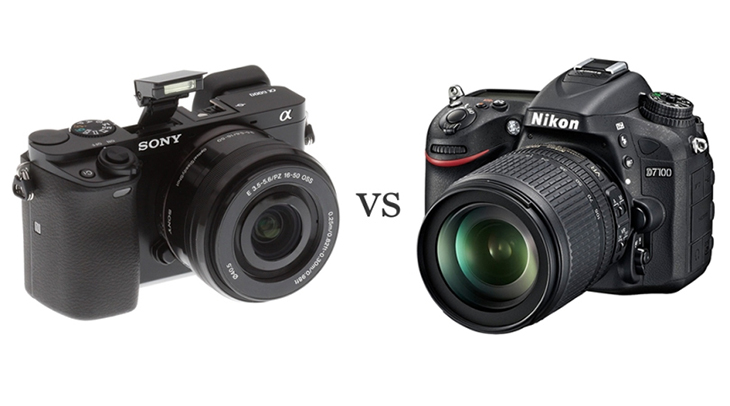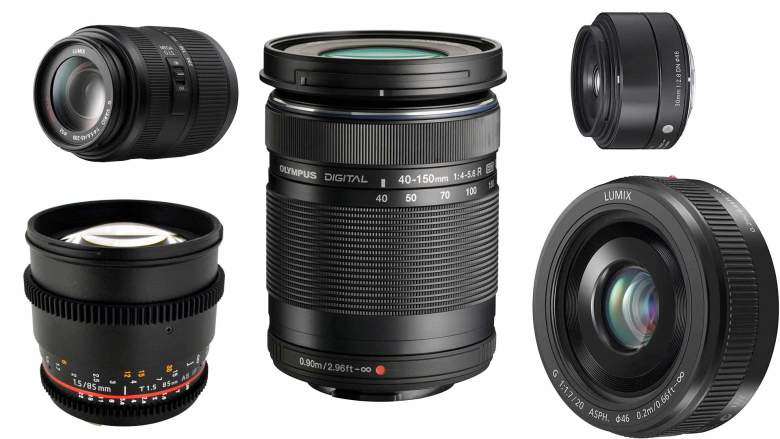You are viewing the article What is a Mirrorless Camera? What’s different from a DSLR? at Tnhelearning.edu.vn you can quickly access the necessary information in the table of contents of the article below.
In the world of photography, two terms that frequently come up are mirrorless cameras and DSLRs. While DSLRs have been dominating the market for years, mirrorless cameras have gained significant popularity in recent times. So, what exactly is a mirrorless camera, and how does it differ from a DSLR?
A mirrorless camera, as the name suggests, is a type of digital camera that lacks the traditional mirror mechanism found in DSLRs. This mirror, located inside DSLRs, reflects light passing through the lens upward, allowing it to reach the optical viewfinder. When the shutter button is pressed, the mirror quickly moves out of the way, allowing light to reach the image sensor and capture the photo.
On the other hand, mirrorless cameras do not have a mirror to reflect light. Instead, they utilize a digital viewfinder or an LCD screen at the back of the camera to display a preview of the image that the sensor is about to capture. The absence of a mirror mechanism results in a more compact and lightweight camera body compared to DSLRs.
Mirrorless cameras also offer several advantages over DSLRs. Firstly, their electronic viewfinders and LCD screens allow photographers to see exactly what the final image will look like before pressing the shutter button. This live preview feature helps in better exposure and composition, making it easier for beginners to learn and experiment with different settings. Additionally, mirrorless cameras usually have faster and more accurate autofocus systems due to their on-sensor focus pixels.
Moreover, mirrorless cameras excel in video recording capabilities. Due to their electronic viewfinders and sensor-based autofocus, they can provide continuous autofocus during video capture, resulting in smooth and sharp footage. Furthermore, their compact size and silent shooting mode make mirrorless cameras perfect for discreet and handheld videography.
While DSLRs still hold their ground in some aspects, such as longer battery life and a wider range of lens options, mirrorless cameras continue to innovate and quickly catch up. They offer a great balance between performance, versatility, and portability, making them an attractive choice for both amateurs and professionals.
In this article, we will delve deeper into the features, advantages, and limitations of mirrorless cameras compared to DSLRs. By the end, you will have a comprehensive understanding of what sets them apart and be able to make an informed decision when choosing the right camera for your photography needs.
Compact size and image quality not inferior to DSLR, Mirrorless cameras are gradually becoming an attractive choice of consumers. So what is a Mirrorless camera, what are the characteristics, what is different from a DSLR camera, let’s find out.
What is a Mirrorless Camera?
Mirrorless cameras are mirrorless digital cameras, based on the mechanism of eliminating image reflections on the viewfinder – an important component of DSLR cameras.
Since there’s no mirror, the image sensor, which is directly exposed to all light, allows you to preview the actual image on the rear LCD screen or on the EVF (Electric Viewfinder).
Additionally, the term Mirrorless is often used to describe ILC (interchangeable) digital interchangeable-lens cameras with an electronic viewfinder or simply without an EVF.
Highlights of Mirrorless Cameras
Size
Mirrorless cameras have a compact size and are relatively lighter in weight than other DSLRs. Because of its compactness, Mirrorless cameras are popular with many people and compete well in the camera market. 
Lens
Lenses are an integral part of a camera that help produce beautiful, high-quality photos. With the development of Mirrorless cameras, vendors have supported the best and fast way to continuously offer a variety of lenses to suit users.
Like DSLRs, mirrorless cameras use bayonet-style mounts to attach different lenses. Each manufacturer has their own proprietary mount, however, many third parties will also produce lenses for those mounts.
The only exception here is Micro Four Thirds, which is used by Panasonic, Olympus and a few other manufacturers such as DJI and Blackmagic Design. Any Micro Four Thirds lens can be used on any camera with the same mount, regardless of brand, compatibility is almost complete.

One of the great things about interchangeable-lens mirrorless cameras is that the distance from the mount to the sensor is much shorter than with a DSLR. This allows users to attach most lenses from DSLR camera manufacturers using the adapter.
Sensor
Despite being much smaller than DSLR cameras, mirrorless cameras can still have similar sized sensors. Canon and Nikon include crop-frame and full-frame sensors on their DSLRs, and similarly, Sony uses both in their mirrorless cameras.
Companies like Fujifilm have gone a step further, equipping not only crop sensors but also medium format sensors, which are even larger than full-frame sensors.

Viewfinder
Mirrorless cameras digitize the scene before shooting with the lens. Equipped with an EVF electronic viewfinder that allows you to zoom in to focus on subjects in low light.
Focusing ability
The autofocus capabilities of mirrorless cameras vary depending on the manufacturer and the lens used with the camera. Therefore, it is difficult to say whether mirrorless cameras have an advantage over DSLRs in this capacity.
In the early days, mirrorless cameras were weaker because they relied on much slower contrast-detect AF systems, but this has improved dramatically in recent times.

Mirrorless cameras are getting much better these days, but DSLRs tend to offer more consistent performance, especially in low light or when shooting or recording moving subjects. motion.
Battery life
Due to the continuous use of the sensor and the LCD or live view EVF, mirrorless cameras typically consume battery power much faster than DSLRs.
For now, the all-day battery life of many DSLRs is still a big plus for some photographers, especially those shooting sports or other live events.
Shooting speed
When the mirror mechanism is removed, the mirrorless camera’s continuous shooting ability is maximized and captures movements at high speed.

Less noise
The Mirroless camera uses an electronic shutter system, so it will limit noise when taking pictures.
Accessory
Mirrorless cameras are becoming more and more popular, so the accompanying accessories are also very rich such as: There are many lens options, many Hot Shoe pins for attaching removable flash, speedlight or Grip to increase battery capacity for the device. ,…
What is the difference between Mirrorless and DSLR cameras?
| Mirrorless Camera | DSLR Camera | |
| Dimensions and weight | Smaller, lighter, and fairly simple in construction. | Large and quite bulky. |
| Ability to focus |
The real-time capture system enables faster image capture when using the LCD monitor. |
Better, especially for high-speed moving objects. |
| Image preview | Can preview the image on the screen, but less effective in low light conditions. | The through-lens optical viewfinder shows you exactly what the camera will capture, even in low light. |
| Image Stabilization Mode |
Using the lens stabilization method, however, with fast movement, it is not good. In addition, some models offer 5-axis image stabilization. |
Uses sensor stabilization, works with all lenses, but doesn’t have 5-axis stabilization yet. |
| Image quality | It has the same quality as a DSLR camera, can take high-quality images, with the same resolution and noise, thanks to the fast processing chip and good noise reduction. | The sensor used is large in size, so it is capable of capturing sharp, well-lit photos with mirrorless quality. |
| Video quality | Because of the on-chip focus sensor, Mirrorless cameras are generally better suited for video recording. | Since phase detection cannot be used during video recording, they must use a slower, less accurate contrast-detection focusing method. |
| The ability to take pictures continuously | The simple mirrorless mechanism allows for more pictures to be taken per second, at higher shutter speeds. | Except for the high-end camera lines, the remaining lines have slower shooting speeds than Mirrorless cameras. |
| Battery life | Consumes a lot of energy due to the use of LCD or EVF. | Provides longer battery life. |
| Lenses and accessories | The use of lenses is very limited. | Most lenses can be used. |
| The price is | Usually cheaper than DSLRs, but you’ll need to buy an extra viewfinder. |
Generally more expensive than mirrorless cameras. Diversity and price to suit your needs. |
Above is the most basic information about mirrorless cameras as well as the difference between this camera line and DSLR cameras, hopefully to help you in choosing to buy a camera.
In conclusion, a mirrorless camera is a modern alternative to a traditional DSLR camera. It offers many advantages to photographers, such as a smaller and lighter body, silent shooting, and enhanced autofocus performance. The absence of a mirror mechanism in a mirrorless camera allows for compactness, making it more portable and convenient to carry around. Additionally, mirrorless cameras excel in video recording capabilities, offering higher resolution and better autofocus tracking. However, DSLR cameras still hold their ground with their excellent optical viewfinder, longer battery life, and wider range of lens options. Ultimately, the choice between a mirrorless camera and a DSLR depends on the user’s specific needs, preferences, and shooting style. With advancing technology, mirrorless cameras are rapidly closing the gap and becoming a compelling choice for both professional and amateur photographers.
Thank you for reading this post What is a Mirrorless Camera? What’s different from a DSLR? at Tnhelearning.edu.vn You can comment, see more related articles below and hope to help you with interesting information.
Related Search:
1. What is a mirrorless camera and how does it work?
2. Mirrorless vs DSLR: Understanding the key differences
3. Pros and cons of mirrorless cameras compared to DSLRs
4. Mirrorless camera technology explained: A beginner’s guide
5. Comparison of image quality: Mirrorless camera vs DSLR
6. Which is better for videography: Mirrorless or DSLR cameras?
7. Understanding the autofocus capabilities of mirrorless vs DSLR cameras
8. Size and weight comparison: Mirrorless cameras vs DSLRs
9. Mirrorless cameras: Revolutionary advancements in electronic viewfinders
10. Price comparison: Mirrorless cameras vs DSLRs



